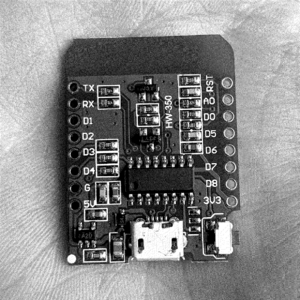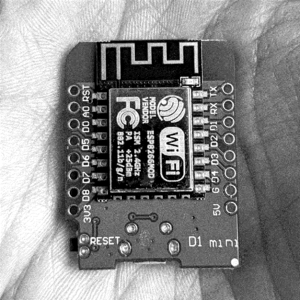| Line 1: | Line 1: | ||
<div class="metadata"> | <div class="metadata"> | ||
== | ==Uns(ui)table Frequencies== | ||
This workshop was convened around a carefully maintained set of networking and publishing infrastructures. Participating in the workshop we gained a privileged access to these tools, services, system memory (which constitute a counter model of networked infrastructure). The ServPub server produces an adaptive refiguring of network infrastructure and collective presence. | |||
Intending to invite a space for imagination and active participation in these networks, I re-purposed the widely available Wifi-enabled microcontrollers (ESP8266) to introduce a series of local-only Wifi access points, programmed to serve a simple messageboard. | |||
My interest in these particular microcontrollers stems from their functionality, offering a low-code entry level into networking devices, that also contains enough flexibility for interesting and surprising uses to emerge. | |||
The intent was for these to act as shadow networks to the primary shared server. It was intended to augment our interactions with the server and the collective writing processes. Additionally to these programmed uses it can also hold other interactions that distort the nested protocols. | |||
Visibly, these microcontrollers break the infrastructure into further discrete nodes. More brittle than the wider network, technical capability is traded for limited parameters, that surface protocological moments into active decisions. The reduced component architecture offers some specificity of the material entanglements. We know where the memory is inscribed and under what levels of permanence. We can also follow the combination of manufacturers at least partially involved in this; Espressif, Ai-Thinker, Wemos. | |||
Limiting this shadow network only to the dev-board without additional components or serial communications, the microcontrollers offer useful visual cues as to their possibility; from the visible printed antenna to the sometimes blinking LED. It also opens up the possibility for them to hide ever more discreetly in public spaces. | |||
If part of our exploration of the shared server is understood in relation to conventional methods digital networking, how does the shared server react to a smaller sibling? | |||
In practice the shadow network remains like weeds growing at the ankles of the ServPub server. To connect to the messageboard or run other services, means disconnecting from the collective spaces of writing on the ServPub server, and the wider internet. | |||
Something that surfaces as an immediate limit is the lack of security offered by the microcontroller. To engage with it in a sustained way requires additional agreements and discussion, emerging from the local context. So it's perhaps always unsuited for activating effective resistance to the dominant form of the internet, but could remain a possible tool for layering upon or around experimental infrastructure, such as the shared server. | |||
It remains a possibility of actions, untaken, and affirming of the practice developed in the shared server. The shadow network follows a Luddite logic of unpicking, allowing space for refusal, the dismissal of certain processes and tools, and the exploration of others, better suited to commonality. It remains open to other passageways of data; a shadow library, a local wiki or static site. | |||
When so much is contingent on a connected internet, subject to ever greater modes of extraction, a template of autonomous zones and fragmented protocols (words lip read without voice) appears as a necessary practice. | |||
(include Wemos D1 pictures if space) | |||
--- | |||
'''Mateus Domingos''' | '''Mateus Domingos''' | ||
| Line 111: | Line 142: | ||
[[Category:Content form]] | [[index.php?title=Category:Content form]] | ||
Revision as of 15:17, 30 January 2024
index.php?title=Category:Content form
- ↑ “ServPub is an experimental platform for research and practice on experimental and computational publishing, to reflect collectively on affective infrastructures, minor tech and autonomous networks within, and beyond, institutional constraints. …Participating communities/institutions include CSNI at LSBU, Creative Computing Institute at UAL, SHAPE at Aarhus University, In-grid, Systerserver, and Varia.” (ServPub)
- ↑ “The writer professes a hope that ‘The House of Commons passes an Act to put down all Machinery hurtful to Commonality, and repeal that to hang Frame Breakers.'” (Binfield, 2004, p57)
- ↑ “In probably the best example of such validation, the frame-work knitters or stockingers, who launched the Luddite protests in Nottingham in 1811, justified their actions by referring to their own originary or constitutive charter, the 1663 Charter of the Company of Framework Knitters.” (Binfield, 2004, p.22)
- ↑ “protocological analysis must focus on the possible and the impossible.” (Galloway, 2004, p53)
- ↑ In WiFi communication the bandwidth refers to 20MHz sectors of frequency. Devices can usually be configured to work within a different sector within the range, if needed, to evade interference. This adaptability is limited by law, the protocol standards and the specific architecture of the antenna. (See also attached table)
- ↑ The microcontrollers I am using are based on the Wemos D1 Mini development board. These make use of the ESP8266 Espressif microchip. I have programmed them using the Arduino IDE. • “Arduino is an open-source electronics platform based on easy-to-use hardware and software." (Arduino, 2018) Arduino is a popular choice for hobbyists to experiment with electronics, often utilising sensors and other components. The IDE is based on the experimental coding IDE Processing, whilst the programming language was based on Wiring (which was also based on Processing) • Espressif is a Chinese semiconductor producer. They are described as a world leading AIoT (Artificial Intelligence of Things) company. By late 2023 they had shipped over 1 billion chips.(Espressif, 2023) They are well known for their ESP range of chips which feature networking components such as WiFi. Their devices are designed to work with Espressif's own open-source SDKs as well as other alternatives, such as Arduino.
- ↑ These microcontrollers are commonly used by artists, experimentally exploiting the networking capabilities. For example, see: Iffy Books (Pocket Wifi Portal Zine, 2022) based on work by Dennis De Bel and Meltronica & MerrittSoft. They are also used extensively in conventional ways as building blocks of networks.


